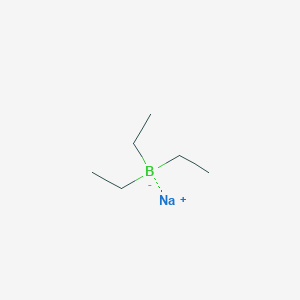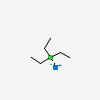Sodium triethylborohydride
- SODIUM TRIETHYLBOROHYDRIDE
- 17979-81-6
- sodium;triethylboron(1-)
- Sodium triethylhydroborate(1-)
- EINECS 241-903-1
- Create:2008-02-05
- Modify:2025-01-11



P231+P232, P260, P264, P280, P301+P330+P331, P302+P361+P354, P304+P340, P305+P354+P338, P316, P321, P363, P370+P378, P402+P404, P405, and P501
(The corresponding statement to each P-code can be found at the GHS Classification page.)
Aggregated GHS information provided per 38 reports by companies from 1 notifications to the ECHA C&L Inventory. Each notification may be associated with multiple companies.
Information may vary between notifications depending on impurities, additives, and other factors. The percentage value in parenthesis indicates the notified classification ratio from companies that provide hazard codes. Only hazard codes with percentage values above 10% are shown.
Water-react. 2 (100%)
Skin Corr. 1B (100%)
Dermatotoxin - Skin burns.
Toxic Pneumonitis - Inflammation of the lungs induced by inhalation of metal fumes or toxic gases and vapors.
Patents are available for this chemical structure:
https://patentscope.wipo.int/search/en/result.jsf?inchikey=UKYGKELSBAWRAN-UHFFFAOYSA-N
Patents are available for this chemical structure:
https://patentscope.wipo.int/search/en/result.jsf?inchikey=KALROQQWUSKVOL-UHFFFAOYSA-N
- CAS Common ChemistryLICENSEThe data from CAS Common Chemistry is provided under a CC-BY-NC 4.0 license, unless otherwise stated.https://creativecommons.org/licenses/by-nc/4.0/Sodium triethylborohydridehttps://commonchemistry.cas.org/detail?cas_rn=17979-81-6
- ChemIDplusSodium triethylhydroborate(1-)https://pubchem.ncbi.nlm.nih.gov/substance/?source=chemidplus&sourceid=0017979816ChemIDplus Chemical Information Classificationhttps://pubchem.ncbi.nlm.nih.gov/source/ChemIDplus
- European Chemicals Agency (ECHA)LICENSEUse of the information, documents and data from the ECHA website is subject to the terms and conditions of this Legal Notice, and subject to other binding limitations provided for under applicable law, the information, documents and data made available on the ECHA website may be reproduced, distributed and/or used, totally or in part, for non-commercial purposes provided that ECHA is acknowledged as the source: "Source: European Chemicals Agency, http://echa.europa.eu/". Such acknowledgement must be included in each copy of the material. ECHA permits and encourages organisations and individuals to create links to the ECHA website under the following cumulative conditions: Links can only be made to webpages that provide a link to the Legal Notice page.https://echa.europa.eu/web/guest/legal-noticeSodium triethylhydroborate(1-)https://echa.europa.eu/substance-information/-/substanceinfo/100.038.079Sodium triethylhydroborate(1-) (EC: 241-903-1)https://echa.europa.eu/information-on-chemicals/cl-inventory-database/-/discli/details/41456
- New Zealand Environmental Protection Authority (EPA)LICENSEThis work is licensed under the Creative Commons Attribution-ShareAlike 4.0 International licence.https://www.epa.govt.nz/about-this-site/general-copyright-statement/Borate(1-), triethylhydro-, sodium, (T-4)-https://www.epa.govt.nz/industry-areas/hazardous-substances/guidance-for-importers-and-manufacturers/hazardous-substances-databases/
- Haz-Map, Information on Hazardous Chemicals and Occupational DiseasesLICENSECopyright (c) 2022 Haz-Map(R). All rights reserved. Unless otherwise indicated, all materials from Haz-Map are copyrighted by Haz-Map(R). No part of these materials, either text or image may be used for any purpose other than for personal use. Therefore, reproduction, modification, storage in a retrieval system or retransmission, in any form or by any means, electronic, mechanical or otherwise, for reasons other than personal use, is strictly prohibited without prior written permission.https://haz-map.com/AboutSodium triethylborohydridehttps://haz-map.com/Agents/21729
- Springer Nature
- WikipediaSodium triethylborohydridehttps://en.wikipedia.org/wiki/Sodium_triethylborohydride
- PubChem
- GHS Classification (UNECE)GHS Classification Treehttp://www.unece.org/trans/danger/publi/ghs/ghs_welcome_e.html
- MolGenieMolGenie Organic Chemistry Ontologyhttps://github.com/MolGenie/ontology/
- PATENTSCOPE (WIPO)SID 388547448https://pubchem.ncbi.nlm.nih.gov/substance/388547448SID 484926337https://pubchem.ncbi.nlm.nih.gov/substance/484926337

 CID 11083947 (CID 11083947)
CID 11083947 (CID 11083947) CID 5360545 (Sodium)
CID 5360545 (Sodium)